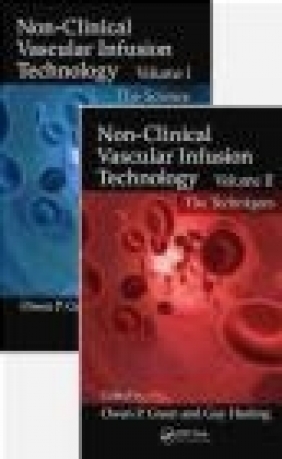Non-Clinical Vascular Infusion Technology, Two Volume Set
Non-Clinical Vascular Infusion Technology, Two Volume Set
- Producent: CRC Press Inc.
- Rok produkcji: 2014
- ISBN: 9781439874400
- Ilość stron: 520
- Oprawa: Twarda
Niedostępna
Opis: Non-Clinical Vascular Infusion Technology, Two Volume Set
Intravenous infusion is a necessary mode of delivery for many pharmaceuticals currently on the market or undergoing clinical trials. The technique of prolonged intravenous delivery in conscious, free-moving animal models has broadened the opportunity to study and evaluate the safety and efficacy of these therapeutic products. For the first time, the collective sciences involved in the understanding of this mode of drug delivery and the methodologies for carrying it out are brought together in a comprehensive work, Non-Clinical Vascular Infusion Technology, Two Volume Set: Science and Techniques. Volume I: The Science covers the scientific principles behind the delivery systems, from both physical and physiological standpoints. It addresses body fluid dynamics, describes the scientific processes necessary to understand the various aspects of the physico-chemical issues relating to vascular infusion delivery, and discusses vascular infusion dynamics. It also considers all the essential elements of the preparation of a formulation intended for vascular delivery as well as assessment of compatibility of the formulation with the dosing apparatus. Volume II: The Techniques builds upon the highly praised Handbook of Pre-Clinical Continuous Intravenous Infusion and provides a current account of the techniques and equipment involved in all the major laboratory animal species for conducting successful vascular infusion studies with xenobiotics. It is organized by species, including all those commonly used in pre-clinical studies: rat, mouse, dog, minipig, large primate, and marmoset. There are also chapters on juvenile studies and reproductive toxicity studies. Each section addresses the selection of the best model, surgical and non-surgical best practices, practical techniques, equipment selection, and commonly encountered background pathologies. Using a fresh approach, the authors identify best practices to be shared across the industry, and provide guidance on choices for the most acceptable methodologies from an animal welfare perspective. This two-volume set provides a foundation of knowledge on infusion technology and its importance for safe clinical use of substances via this route of delivery. "Owen Green and Guy Healing have shown the importance of the 3Rs in infusion technology at international meetings and in producing this book." -From the Foreword by Kathryn Chapman, Head of Innovation and Translation, the National Centre for the Replacement, Refinement and Reduction of Animals in Research Praise for the First Edition, Handbook of Pre-clinical Continuous Intravenous Infusion " ... an excellent buy for anyone involved in drug development, risk assessment or within drug licensing agencies and in academic research. ... This book represents a benchmark achievement for this technique ... it will become the standard for many years to come." -British Toxicology Society NewsletterVOLUME I: Body Fluid Dynamics Introduction Composition and units of measurement Compartmentalization and Distribution Movement between Compartments/Exchange Body Fluid Homeostasis Summary References Physico-Chemical Factors Introduction Osmolality Acid-Base Balance Viscosity Surface Tension Diffusion Summary of Infusion Forces References Vascular Infusion Dynamics Essential physiology Intravenous Delivery Rates and Volumes References Formulation Considerations, Co-author: Kevin Sooben Introduction Formulation selection strategy Study design and species/strain The properties of the compound Strategies for dealing with poor solubility Unwanted formulation effects Excipient toxicity Strategies for dealing with injection site reactions and haemolysis Strategies for dealing with poor stability Sterility Conclusion References Prestudy analytical assessments: Equipment compatibility, Co-author: James Baker Introduction Stability of the formulation with the formulation storage vessel Compatibility Choice of material References Haemocompatibility, Co-author: Sophie Hill Introduction Objectives. Methods of assessing haemocompatibility Discussion Conclusion References Annex: Common excipients and vehicles VOLUME II: Rat Jennifer Sheehan, Duncan Patten and Vasanthi Mowat Mouse Hans van Wijk and Alice J M Fraser Dog John Cody Resendez and David Rehagen Primate Christine Copeman and Stephanie Clubb Reproductive models Minipig Peter Glerup, Mikala Skydsgaard and Gitte Jeppesen Juvenile animals Teresa R. Gleason and George A. Parker Marmoset Dr. Sven Korte, Dr. Piotr Nowak, Dr. Jorg Luft and Dr. Birgit Niggemann
Szczegóły: Non-Clinical Vascular Infusion Technology, Two Volume Set
Tytuł: Non-Clinical Vascular Infusion Technology, Two Volume Set
Producent: CRC Press Inc.
ISBN: 9781439874400
Rok produkcji: 2014
Ilość stron: 520
Oprawa: Twarda
Waga: 1.16 kg





















